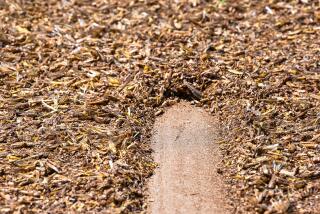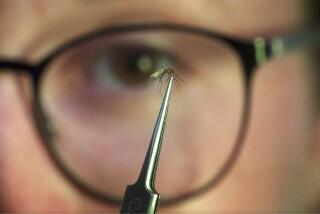Mormon Crickets Scour Utah Crops
- Share via
SALT LAKE CITY — To some farmers in rural Utah, it must seem a plague of biblical proportions. Crickets and grasshoppers, thousands--no, millions--of them, descending on crops, covering fields and roads in a seething, buzzing black mass, eating everything in sight.
This is the time of year when Mormon crickets--actually a type of grasshopper--lay their eggs and other grasshopper varieties take over as the major pests for the rest of the summer.
In June, Gov. Mike Leavitt declared an agricultural emergency as the grasshoppers threatened to devour crops in 18 Utah counties.
Cricket populations are surging after several consecutive warm winters. Leavitt said this year’s infestation is the worst in Utah since the 1940s. State agricultural officials predict farmers could lose more than $25 million in damaged crops such as wheat, barley, alfalfa, safflower and rangeland grasses.
Local lore says just such an invasion threatened crops in the state’s early days: Faced with starvation, the pioneers prayed, and God sent a flock of sea gulls to munch the crickets, regurgitate them into the Great Salt Lake and come back for more, until the pests were gone.
Utah farmers might be wondering where the birds are now.
Leavitt’s emergency declaration will allow farmers to get government money to combat the infestation and be repaid for their losses. The state is seeking as much as $5 million.
Rather than pray for a miracle, farmers are trying to combat crickets with poison. The going is grim.
“The situation is not getting better,” said Larry Lewis, Utah Department of Agriculture and Food spokesman.
In many fields, inspectors see crickets on nearly every stalk of wheat--a rate equaling about 2 million crickets on each of the 1.5 million square miles affected, Lewis said.
The cricket-poisoning program is funded largely through the Bureau of Land Management. Poisoned grain is spread in areas where crickets are known to migrate. The grain is dropped from the backs of all-terrain vehicles, away from water sources and sensitive wild areas, said Larry Maxfield, a manager for the bureau.
The crickets eat the poison and then, as they die, are often eaten by their fellow crickets.
“They like to eat a lot, and they have no preference whether it be alfalfa or one of their own,” Lewis said. “One ingestion of the bait will go through three to five crickets.”
Environmentalists say the pioneers’ method of cricket control is worth rethinking.
“What we fear is that a lot of the animals that would normally eat the crickets are either eating the poisoned grain or the crickets and are poisoned themselves,” said Craig Axford of the Utah Environmental Congress.
But state and federal officials say the bureau has done environmental impact assessments and has never found evidence of harm to either humans or wildlife.
More to Read
Sign up for Essential California
The most important California stories and recommendations in your inbox every morning.
You may occasionally receive promotional content from the Los Angeles Times.













